Stay Updated
My Book is Out!
To The Fishes of Ohio"
is available for purchase. It contains updated information of all fishes that are in Ohio waters. You can order it through the Ohio Biological Survey website.
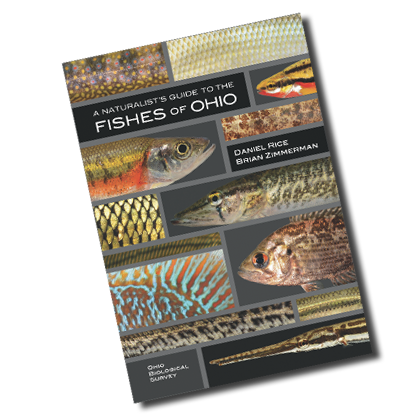
Sunfish
Warmouth Sunfish - Lepomis gulosus
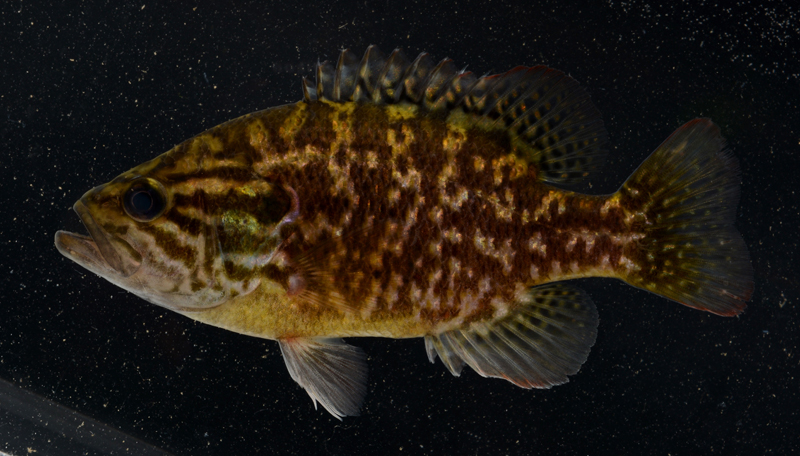
Male
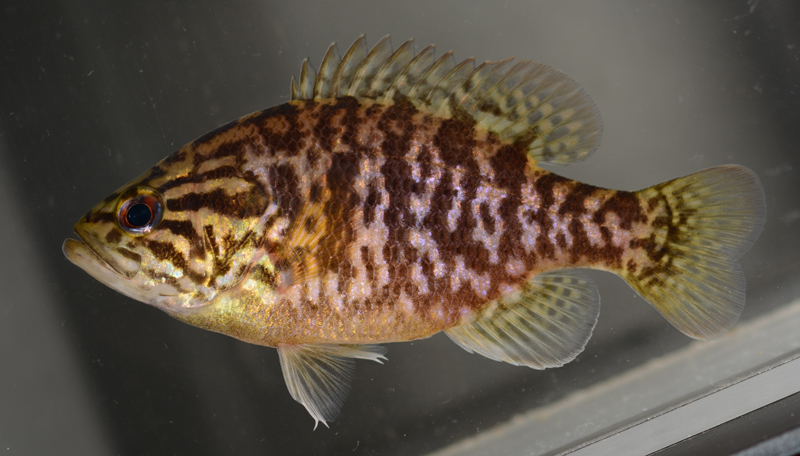
Female
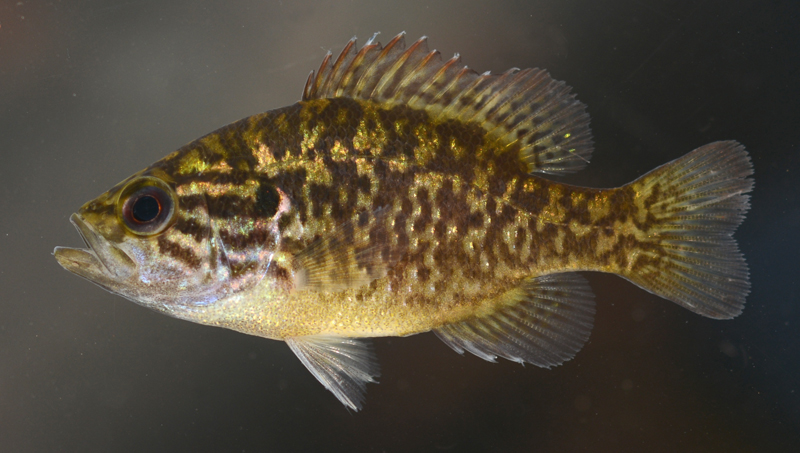
Juvenile
Captive Bred
Adult
Current Size: 1 - 1.5 inches
Max Size:
Males: 7 - 8 inches
Females: 5 - 7 inches
Occasionally well cared for male fish can reach 10 inches.
Price: $10.00
Origin: Warmouth are found throughout large parts of eastern North America in slower moving streams, wetlands, oxbows, and natural lakes. They prefer calm waters with lots of cover in the form of aquatic vegetation, logs, and brush piles. They are usually absent from fast moving rocky streams and rivers.
Coloration: They have a unique color pattern that can be highly variable and change quickly to blend in with their surroundings. They have a dark base color with specks of gold, orange, yellow or black. Fins can be outlined with a thin edge of white, orange or even red on some individuals. Males have a red/orange spot at the rear base of the soft dorsal fin.
Tank Size: They are great fish for larger aquariums or water gardens. They can also work as a single fish in a smaller tank. They are less territorial than most sunfish but have a big appetite with their oversized mouth allowing them to consume smaller tank mates, so choose similar sized fish. A single individual could be kept in a 20 gallon aquarium with good filtration. Consider a 55 gallon tank or larger for a group of 4 or more individuals. They enjoy a well decorated aquarium with lots of cover in the form of rocks, driftwood, or live plants.
Feeding: This is a naturally very secretive fish in nature but adapt quickly in captivity to beg for food like other sunfish. They are not picky eaters and will take a wide variety of high protein pellets or frozen foods such as blood worms, mysis shrimp, or krill. This is a species that can be fed live feeder fish, but it is not required.
Water Conditions: Cold hardy so can winter over outdoors in a water garden. Can handle temp of 34-85 F. Spawn at 75-80 F. PH of 7-8.5.
Ozark Longear Sunfish - Lepomis megalotis
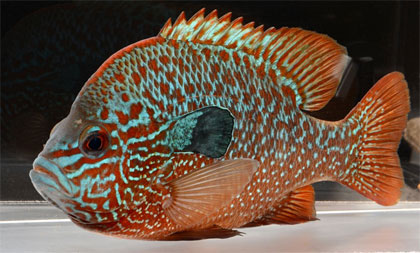
Male
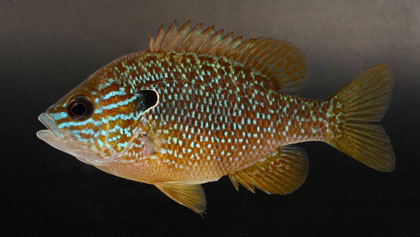
Female
Captive Bred
Juvenile
Current Size: 1 - 2 inches
$10.00
Adult
Max Size:
Males: 6.5 - 7.5 inches
Females: 4.5 - 5.5 inches
No Stock
Origin: This particular strain of Longear Sunfish originates from the western part of the Ozarks in the Missouri and Arkansas River basins. They are most often found in clear rivers and streams. Longear Sunfish as a whole have a much larger distribution from the western slope of the Appalachian Mountains south westward to the northeast edge of Mexico.
Coloration: Ozark Longear Sunfish are in our opinion the most attractive looking sunfish, and our favorite fish! The colors of adult males rival any tropical, or marine fish with the most distinctive character of this strain being the red/orange stripe down the nape (middle of head/forehead area). Large males are covered in bright red/orange and blue speckling, particularly on the sides of the face where the colors form alternating lines. Even the females have nice coloration only a little less intense.
Tank Size: They are great fish for larger aquariums or water gardens. They can also work as a single fish in a smaller tank. They are territorial so if kept in groups we recommend 6 or more individuals in a 55 gallon or larger aquarium with good filtration. Making your aquarium more complex with lots of cover in the form of rocks, driftwood, or durable live plants helps break up lines of sight for separate territories for each individual fish in the tank.
Feeding: Like most sunfish they are very personable and quickly learn to beg for food. They are not picky eaters and will take a wide variety of high protein pellets, or frozen foods such as blood worms, mysis shrimp, or krill.
Water Conditions: Cold hardy so can winter over outdoors in a water garden. Can handle temp of 34-85 F. Spawn at 75-80 F. PH of 7-8.5.
Livebearers
Melanistic Eastern Mosquitofish - Gambusia holbrooki
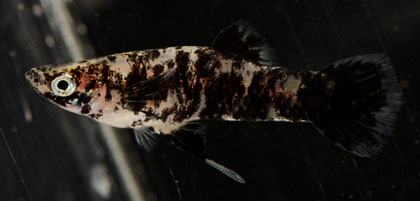
Male
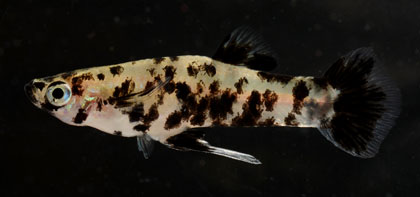
Male
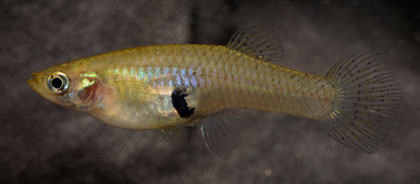
Female
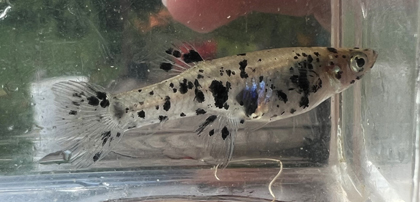
Female
Captive Bred
Adult
Max Size:
Males: 1.25 inches
Females: 2.5 inches
$10.00 for sexed pair
$6.00 each for 1 fish
Origin: Found on the coastal plain from the Carolinas, throughout Florida and along the Gulf Coast west to southern Alabama and Mississippi. I originally caught my stock in Florida and have been line breeding these for over 5 years now. I have added a few additional wild caught melanistic males to my breeding group since the original capture. At this point the majority of the males produced in this line are melanistic, probably better than 90% of the males produced. I continue to remove any normal gray males produced from my population. I recently found the first melanistic female! This is incredibly rare I have never seen one in the wild! Hopefully, with continued effort I will see even more of these rare females. Sorry, this fish is not for sale, I hope to get some young from her and use them to continue my line.
Coloration: These are normally a small gray fish with a few tiny black spots on the fins. The melanistic trait appears in the wild population on a small percentage of males giving them the dalmatian look of random black blotches and spots over a white or even translucent background. Females are a plain gray with the black spots in rows on the fins.
Tank Size: They don't need a lot of space even a 10 gallon tank is suitable for a small group. They do eat their fry so they are not a great livebearer for colony breeding. I like to use a layer of the floating plant hornwort, also known as coontail (this can be rooted but does fine just floating on the surface), and check the tank for fry hiding among this daily. This helps a lot with getting some young to survive. Bigger the tank and more hiding places the less of a need to remove the fry there is, you will get some survival with a dense layer of plants in a bigger (40 breeder or so) tank. I like to use smaller tank (20 long in winter) and then just remove the young when I find them.
Feeding: Not picky will feed well on flake food. I also feed mine some frozen baby brine shrimp and blood worms but this may not be necessary.
Water Conditions: Not Cold hardy in northern states like their close relative the Western Mosquitofish Gambusia affinis but can be kept outdoors in the southern US. Probably handles temps down in the 40’s just can’t handle ice. Do well outdoors in water garden ponds or even a tub on a porch in summer further north. Do not need to be heated indoors but I have found they produce more young in a heated aquarium kept at 75-80 F. PH of 6.5-8.5.
Shipping & Handling
- Customers are responsible for making sure they understand their local laws and have the proper permits that apply to their particular situation regarding the legality of purchasing, importing, or owning any of our fish in their state.
- We ship to US customers only. We use USPS Priority Mail to ship our fish.
- They should arrive in 2-3 days. We ship out on Monday & Tuesday to ensure a safe and live arrival.
- We also offer Express Mail by request.
- Prices depend on how many fish you are ordering.
- Priority Shipping starts at $15.00. We would be more than happy to give you a quote.
Payment
- We accept Personal Checks, Money Orders, or Paypal.
- Sorry no credit card or debit card payments at this time. Make your check/ Money orders to: Zimmermans Fish
- Once we receive your payment, your fish will go out on the following Monday or Tuesday.
- You will receive an email, so that you will know when to expect your fish.
- We package our fish by double bagging them in thick 3mil plastic bags, fresh clean water, and oxygen. They are then placed in an insulated box for shipment.
Brian and Julie Zimmerman
Phone: 330 417 9476 Email: smbass444@yahoo.com